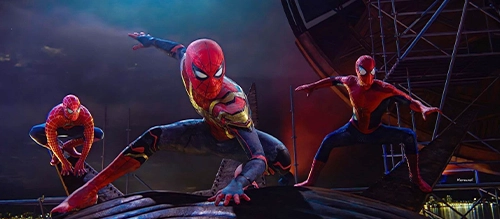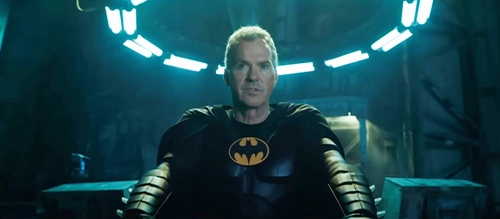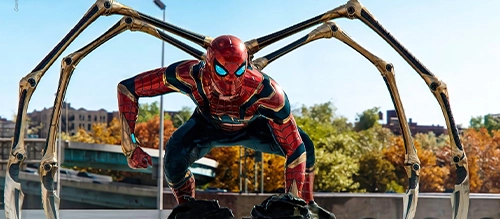Cameo Killed the Superhero Movie
In a new age for the genre, its latest recipe for success is fast growing stale.
It’s no secret that Marvel have had a monopoly on the cinema industry for well over a decade now. The superhero franchise, boasting its critically acclaimed (and extremely profitable) cinematic universe, employs a wide variety of techniques that keep audiences around the globe returning to their closest big screen with each and every release. But no strategy gets people quite as excited as the incorporation of cameo appearances from fan favourite characters and actors. This inclusion has been a staple of superhero cinema more or less since the beginning, with examples like Tony Stark in The Incredible Hulk in place to tease the next slew of releases, but it has undoubtedly been revolutionised since the 2021 release of Spider-Man: No Way Home.
What occurred in the fallout of Tobey Maguire and Andrew Garfield making their highly anticipated return was nothing short of pioneering. Fans gathered far and wide on release day, brimming with enthusiasm in the hopes of seeing not one, not two, but three Spider-Men swinging, crawling and crime-fighting together. Unsurprisingly, the film was met with praise from critics and fans alike.

The Guardian, whilst carefully avoiding spilling the beans, referred to the film as “all very meta and self-referential; screenwriters Chris McKenna and Erik Sommers hoover up memorable lines from past movies and serve them with a flourish and an exaggerated wink to the audience. It’s also a good deal of fun.” Just how exaggerated are we talking?
Meanwhile, rogerebert.com writer Brian Tallerico alluded to No Way Home’s big surprise by asserting: “there’s more going on here than the previews would have you believe.” He went on to say: “More than any movie in the MCU that I can remember, it made me want to dig out my old box of Spider-Man comic books. That’s a heroic accomplishment.”
Above all else, the numbers don’t lie. No Way Home brought in just under $2 billion for Sony and Marvel, a staggering figure postulating the film as one of the highest-grossing ever.
Approved by critics, lauded by fans, bringing in a king’s ransom. Cue the light bulb moment for filmmakers everywhere.
Since No Way Home, embracing cameos has become a leading approach for a fair share of films within the same genre. 2023 saw the long-awaited release of The Flash, the thirteenth instalment of long-time Marvel rivals DC’s own extended universe. Following various delays, ranging from director changes to COVID-19 to the controversy surrounding its lead, the film carried with it plenty of pressure. Cast alongside Ezra Miller was a returning Michael Keaton, reprising his role as Bruce Wayne/Batman after over 30 years. Unlike the Maguire and Garfield case of No Way Home, Keaton’s involvement wasn’t kept secret, however this didn’t prevent the veteran actor from taking a significant slice of The Flash’s overall appeal.

What director Andy Muschietti didn’t reveal prematurely was the host of surprise cameos that would feature in the film’s third act. Adam West, Christopher Reeve, George Reeves. These three actors share three commonalities: they all played DC superheroes. They’ve all passed away. They’re all in The Flash. In a brief but memorable sequence near the film’s conclusion, the aforementioned actors (through the magic of CGI) come to life onscreen in the hopes of thrilling viewers much like No Way Home did. The brevity of the scene suggests that this inclusion came rather late in the film’s development, most likely a swift response to Marvel’s monumental success two years prior. It’s important to note that this is all speculation, but it doesn’t take an Avenger to see it.
Yet there’s a key difference here. None of the surprise cameos have any dialogue, any direct involvement in the film’s overarching narrative, and barely any screen time at all. It feels like a cheap attempt at recreating the charm of a better film. And, taking into account that a majority of these actors have passed on, it also feels exceedingly insensitive.
This is a sentiment shared over at rogerebert.com, with writer Matt Zoller Seitz making reference to the scene in his review of the film: “And rather than find an artful, modest way to repurpose library footage from earlier adaptations of DC comics, the actors who originally played them, many of whom died long ago, have been scanned (or rebuilt) as vaguely three-dimensional but uncanny grotesques.”

Considering the lack of… everything in these cameos, why include them at all? Was there a fear that the story couldn’t stand on its own? Were the writers under too much pressure to live up to Marvel’s supremely high standard? Or was this a dreadfully sleazy attempt at cashing in on the hype?
If the latter is true, director Andy Muschietti and company have failed miserably. So far (as of 14th July 2023), The Flash has grossed a lowly $262.6 million against its $200 million budget, which coincidentally, is the exact same budget Sony and Marvel allocated for Spider-Man: No Way Home. In addition, the film, and its cameo sequence in particular, were received to every filmmaker’s worst nightmare: mixed opinion.
The Flash isn’t the only superhero film to exploit the new-age cameo, Sony’s Spider-Man: Across the Spider-Verse, despite being well received, also features a blink-and-you’ll-miss-it Donald Glover, supplied with a one-line quip and no more. Less controversial, but also similarly useless. The third Deadpool film will resurrect Hugh Jackman’s Logan, but only time will tell if this move was made with sincerity or a lack of ulterior motive.

It seems this trend is, for now, here to stay. So far, none have succeeded in matching No Way Home in any department, and there’s a couple of reasons why. For the MCU’s third Spider-Man instalment, the fans and their wishes were paramount. Maguire and Garfield stealthily signed on to the film while it was halfway through production, as a result of heavy anticipation for their returns. Importantly, both actors signed on only after being assured that their involvement would be integral to the film, and not simply to bolster the film’s unique selling point. These factors are void in films like The Flash. Aside from Keaton, none of the cameos amount to anything more than a brief eyebrow-raising moment, abutted by a series of half-baked CGI fight scenes and an absence of decency.
This shortage of genuineness suggests fans and their enthusiasm are sadly being exploited for a quick buck. Whilst No Way Home took the cameo craze to an unprecedented level, it also inspired a shedload of dime a dozen copycats, indolent scriptwriting and an overt presentation of what cinema goers already knew about big budget filmmaking: profit is the first concern.
The Flash’s humble returns suggest audiences are at least becoming privy to this and are making it known in response that they aren’t satisfied. Superhero films are often renowned for their heart, and when such heart plays hooky, someone must be held accountable.
Written by Ibrahim Azam
You can support Ibrahim in the following places:
Medium: @ibrahimazam99
Instagram: @ibrahimsfilms
Letterboxd: ibrahimazam00

